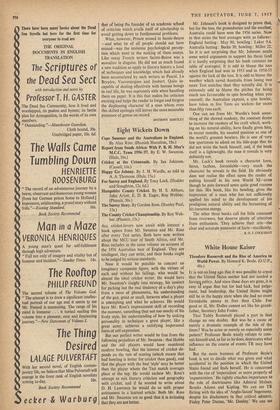Eight Wickets Down ,
Report from South Africa: With P. B. H. May's M.C.C. Team 1956/57. By E. W. Swanton. (Hale, 16s.) Hampshire County Cricket. By H. S. Altham, John Arlott, E. D. R. Eager, Roy Webber. (Phoenix, 30s.) The County Cricket Championship. By Roy Web- ber. (Phoenix, 15s.) ALL cricket-lovers now await with interest a book apiece from Mr. Swanton and Mr. Ross after every Test series. Both have now written about the MCC tour of South Africa, and Mr. Ross includes in the same volume an account of the 1956 Australian tour of England. They are intelligent, they can write, and their books ought to be judged by serious standards.
Now it would be possible to concoct an imaginary composite figure, with the virtues of each and without his failings, who would be almost the ideal cricket writer. He would have Mr. Swanton's insight into strategy, his instinct for picking out the real tendency of a day's play from a mass of phenomena, his understanding of the gap, great or small, between what a player is attempting and what he achieves. He would have Mr. Ross's impressionist skill of recording the moment, something (but not too much) of his lively style, his understanding of how by sinking personality in technique a great player, like a great actor, achieves a satisfying impersonal form of self-expression.
But our perfect writer would be free from the following prejudices of Mr. Swanton: that Hobbs and the old players would have murdered modern bowling, that the interest of cricket de- pends on the rate of scoring (which means that bad bowling is better for cricket than good), and that the player with the best `style' may be better than the player whom the Test match averages place at the top. He would eschew Mr. Ross's attempt to mix literary criticism and geography with cricket, and if he wanted to write about D. H. Lawrence he would do so with proper seriousness in a learned article. Both Mr. Ross and Mr. Swanton are so good that it is irritating that they are not better.
Mr. Johnson's book is designed to prove that, but for the toss, the groundsman and the weather, Australia could have won the 1956 series. Now in that series the best averages were as follows: England batting: May 90; bowling : Laker 9.6. Australia batting : Burke 30; bowling : Miller 22. So it is not surprising that Mr. Johnson needs some weird arguments to support his thesis (and it is hardly surprising that his book contains no table of averages). It is odd to blame the toss when England had won in 1953 and in 1954-55 against the luck of the toss. It is odd to blame the weather which saved Australia from losing two more Test matches than they actually did. It is extremely odd to blame the pitches for being much too favourable to spin bowling when you yourself, the Australian captain, a spin bowler, have taken in five Tests six wickets for more than fifty runs each.
One can see from Mr. Wardle's book some- thing of the shrewd modesty, the constant desire to increase the mastery of his craft which, work ing on his natural ability, have finally given him, in recent months, his assured position as one of the world's greatest bowlers. He is one of very few sportsmen to admit on his title-page that he did not write the book himself, and, if the book itself is a lightweight, the man it reveals is very definitely not.
Mr. Lock's book reveals a character keen, fierce, tactless, formidable—very much the character he reveals in the field. He obviously does not realise the effect upon the reader of putting himself in his own World XI—even though he puts forward some quite good reasons for this. His book, like his bowling, gives the impression of a man who has not sufficiently applied his mind to the development of his prodigious natural ability and the harnessing of his immense energy.
The other three books call for little comment
from reviewers, but deserve plenty of attention from enthusiasts. They achieve their aim—the clear and accurate statement of facts—excellently. A. 0. J. COCKSIIUT


































 Previous page
Previous page